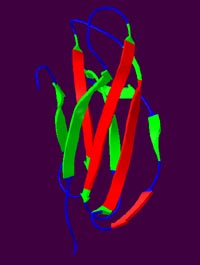
|
 |
Discovery may improve treatment of neurodegenerative diseases
Dec 15, 2005, 16:14, Reviewed by: Dr. Sanjukta Acharya
|
|
"This method identifies potential therapeutic targets against illnesses caused by protein aggregation, such as Alzheimer's, Parkinson's and type 2 diabetes. It allows a more precise identification of the targets, meaning that in theory they can be attacked more effectively"
|
By Universitat Autonoma de Barcelona,
A team of scientists from the Universitat Aut�noma de Barcelona, led by the researcher Salvador Ventura, has developed a method that allows those parts of the proteins that set off aggregation to be identified. Using this method one is able to identify the precise zones of each protein that force these proteins to bond, aggregate and form amyloid fibres. The scientists have tested the method with different proteins involved in conformational diseases, while identifying zones that were already known for their role in protein aggregation and the neurodegenerative diseases, such as Parkinson's, Alzheimer's, and forms of spongiform encephalopathy, such as mad cow disease (BSE) and its human form, Creuzfeldt-Jacob disease.
Proteins are large molecular chains that move around cells carrying vital information on the activity of the organism. The role of each protein depends largely on the form it takes, but the proteins occasionally lose this form when they collide and bind with other proteins. They aggregate, and lose their function, growing continuously to form what are known as amyloid fibres. This causes neurodegenerative diseases, such as Parkinson's, Alzheimer's, and forms of spongiform encephalopathy, such as mad cow disease (BSE) and its human form, Creuzfeldt-Jacob disease. It also produces the pancreatic malfunctions that cause type 2 diabetes.
According to Salvador Ventura, their method "identifies potential therapeutic targets against illnesses caused by protein aggregation, such as Alzheimer's, Parkinson's and type 2 diabetes. It allows a more precise identification of the targets, meaning that in theory they can be attacked more effectively".
 |
| Globular protein |
The method created by the UAB researchers identifies the "hot spots" that cause protein aggregation both in globular proteins, which are folded chains, and in unfolded chains. This method may be extremely useful for designing new drugs to fight illnesses related to protein aggregation. For unfolded chains, the method can be used to design drugs that act by completely covering and shielding the "hot spots" identified through the new method so that they cannot come into contact with other proteins and aggregate. If the proteins are globular, the aggregation "hot spots" are usually protected on the inside, and are not dangerous unless they are accidentally exposed to the outside. In this case the drugs must be aimed at stabilising the structure of the protein, while preventing the "hot spots" from becoming exposed. 
- BMC Structural Biology
www.uab.es
The research, recently published in BMC Structural Biology, was carried out by Natalia S�nchez de Groot, Irantzu Pallar�s, Francesc Xavier Avil�s, Josep Vendrell and Salvador Ventura, of the Department of Biochemistry and Molecular Biology and the Institute of Biotechnology and Biomedicine (IBB) at the Universitat Aut�noma de Barcelona.
|
For any corrections of factual information, to contact the editors or to send
any medical news or health news press releases, use
feedback form
Top of Page
|
|
|
|